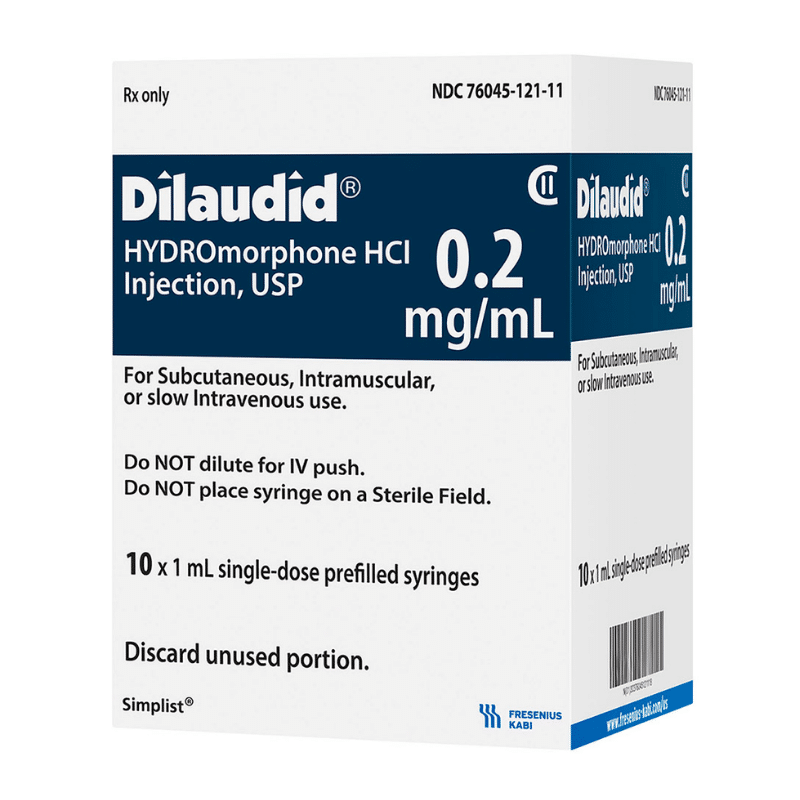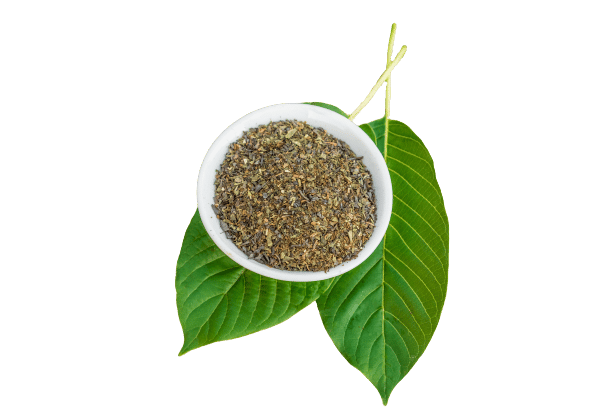Does Kratom Interact With Hydromorphone?
Yes — mixing kratom and opioids like hydromorphone will increase your risk of an overdose and other adverse effects.
Kratom and hydromorphone are both central nervous stimulants that act on opioid receptors. When two substances that cause similar effects on the body or work through the exact mechanisms of action are taken together, they can cause a more significant effect overall. This phenomenon is known as an agonistic interaction.
The agonistic interaction between kratom and hydromorphone increases the incidence of harmful events due to drug buildup. Kratom alone rarely causes death, but most deaths that involve kratom also involve opioids.
Hydromorphone is not processed by the CYP450 enzymes like other opioid analgesics [1]. This means that kratom and hydromorphone have separate metabolic pathways and are not metabolic competitors.

Hydromorphone Specs
| Drug Name | Hydromorphone |
| Trade Name | Dilaudid, Exalgo, Palladone, Hydromoprh |
| Classification | Opioid analgesic |
| CYP Metabolism | None. Hydromorphone is metabolized by glucuronidation in the liver. |
| Interaction With Kratom | Agonistic |
| Risk of Interaction | High |
Is it Safe to Take Kratom With Hydromorphone?
No — this interaction carries significant risk.
Hydromorphone is a hazardous compound and should not be combined with other drugs unless under strict doctor supervision.
Kratom is relatively safe — deaths involving kratom are almost always linked to other, more dangerous compounds such as heroin [2].
So, as safe as kratom is, combining it with a powerful opioid such as hydromorphone is an unsafe and dangerous choice.
What is Hydromorphone?
Hydromorphone, sold under the brand name Dilaudid, is a prescription opioid analgesic. It is a potent medication; according to the DEA, it is 2-8x more powerful than regular morphine.
The precise mechanism of action for hydromorphone is unknown, but it works by activating opioid receptors in the brain and spinal cord.
Hydromorphone is a Schedule II substance, meaning it has recognized medical uses but also carries a high potential for abuse and dependence.
Indicated for moderate to severe acute pain and severe chronic pain, hydromorphone may be administered orally or by injection. Its effects usually take an hour to begin and last up to five hours.
Hydromorphone is on the World Health Organization’s List of Essential Medicines and is available as a generic medication.
What is Hydromorphone Used for?
Hydromorphone is prescribed to treat severe chronic pain, usually the kind that has not responded well to alternative treatments.
Since it is a powerful compound with a substantial risk of adverse effects, you shouldn’t use hydromorphone except in severe cases like cancer.
Although there are differences, hydromorphone possesses a similar profile to other opioid analgesics, such as morphine and oxycodone.
Hydromorphone is usually given to patients that respond negatively to morphine [3].
Hydromorphone is more potent than other opioid analgesics, but studies attempting to distinguish the traits of these drugs have not found conclusive results [4].
What’s the Dose of Hydromorphone?
Doctors may prescribe hydromorphone administration through intramuscular, intravenous, subcutaneous, or oral routes. When injected, the maximum concentration is of 10 mg/ml [5].
Hydromorphone is a dangerous medication. You should only take it in accordance to a legitimate doctor’s prescription; generalized dosage recommendations on the internet can never consider all the necessary factors.
Additionally, drugs such as hydromorphone are usually carefully titrated, slowly exposing the drug to the body to limit the potential for side effects. A licensed physician best handles titration.
Also, certain conditions like renal impairments can affect the proper dosage of hydromorphone.
In conclusion, only take hydromorphone as instructed by a doctor. Otherwise, you run a significant risk.
Generic & Brand Name Versions
The brand name versions of hydromorphone are:
- Dilaudid
- Dilaudid-5
- Exalgo
- Palladone
- Contin

What Are the Side Effects of Hydromorphone?
Hydromorphone has comparable side effects to other opioid analgesics.
The use of hydromorphone carries the risk of the following adverse effects:
- Adrenal Insufficiency
- Depression
- Hormone imbalance
- Respiratory depression
- Severe hypotension
- Withdrawal symptoms
Less severe side effects include:
- Anxiety
- Drowsiness/lightheadedness
- Dry mouth
- Headaches
- Stomach pain
- Sweating
The concomitant use of hydromorphone with benzodiazepines or other central nervous system depressants carries an even greater risk of a severe event.
Hydromorphone use during pregnancy is heavily discouraged.
What is Kratom?
Kratom is made out of the leaves of the Mitragyna speciosa tree — a species of evergreen tree native to Southeast Asia.
Southeast Asian farmers and indigenous peoples have used it as traditional medicine to combat fatigue and anxiety, but it’s just starting to become known in the west.
Typically, indigenous people from Vietnam, Indonesia, Thailand and the region of Borneo, chew on the raw kratom leaves for an energy boost and to combat pain. However kratom is now available in various forms, including crushed powder, capsules and tinctures. People also enjoy brewing kratom leaves into tea from time to time.
What is Kratom Used for?
We’re only now beginning to study kratom, but what we do know shows promise. Kratom has many uses, but we’ll focus on the main ones.
Low doses are capable of increasing mental energy and display mood-enhancing properties.
Higher doses provide pain relief and promote a good night’s sleep.
Furthermore, kratom has been used successfully as a weight-loss supplement
With further research, we can surely expect more uses to be discovered.

What’s the Dose of Kratom?
When dosing kratom — there are too many factors to consider. Use the following information as a starting point, but remember that your weight, the effects you want, and whether you’ve eaten or not will significantly affect how much kratom you need.
The most important thing to remember is to go slow and listen to your body, especially if you’re a newcomer to kratom.
The general kratom dosage recommendations are:
- Low dose (1 – 5 g)
- Medium dose (5 – 10 g)
- High dose (10 – 15 g)
Related: How Long Should I Wait Between Kratom Doses?
What Are the Side Effects of Kratom?
Kratom is pretty forgiving. If you accidentally take too much, you’ll probably become nauseous and dizzy, but that’s about it. Kratom has a few side effects to be aware of, but they’re minor.
Kratom’s common side effects are:
More severe side effects include:
- Itchiness in the skin
- Liver damage (with long-term use)
- Loss of muscle coordination
- Low blood pressure
- Low libido
- Nausea
- Poor appetite
- Seizures
- Tremors
If you’re experiencing too many side effects due to kratom, you’ll need to cut back on the amount you’re ingesting.
When misused, kratom has the potential to cause symptoms of mental and physical dependence. This addiction, however, is very mild when compared to opiate or benzodiazepine dependences.
Lastly, it is not recommended to use kratom when pregnant or breastfeeding.

What Are the Different Types of Kratom?
Good news for all who like to tweak their consumption to find the perfect experience: kratom is available in various strains and each offers unique effects.
These strains contain the same basic properties, but each emphasizes specific effects to differing extents.
Make sure to try out different strains to find the one that works best for you. Remember that even though they are all named after a specific color, they’ll look the same once processed.

White Vein Kratom
White vein kratom offers mind-based, nootropic benefits, such as increased attention span, creativity, a general improvement in mental energy, and euphoria.
If qualities sound like what you’re looking for, then you should try a white-veined strain.

Red Vein Kratom
As opposed to white vein kratom, the red-veined kratom strains are analgesic and anxiolytic, making them quite popular with those who suffer from anxiety and chronic pain.

Green Vein Kratom
Green vein kratom is a jack of all trades. It has an outstanding balance between the alkaloid profiles of white and red-veined strains.
If you’re new to kratom and want to try a strain that emphasizes all of the kratom’s benefits, green is the choice for you.
Just remember that you are forgoing the more targeted experience of a white or a red.

Yellow Vein Kratom
Yellow vein kratom is similar to green-veined strains.
The significant difference is that yellow-veined strains are milder, making them perfect for beginners or those who have a sensibility to kratom.

Key Takeaways: Is it Safe to Mix Kratom & Hydromorphone?
No, there are many risks when combining kratom and hydromorphone.
Kratom has shown promise in treating opioid withdrawal symptoms and could help someone wean off hydromorphone.
If this is a strategy you want to implement, contact your doctor for guidance.
Besides that, the combination of hydromorphone and kratom is best avoided.
- Gregory, T. B. (2013). Hydromorphone: evolving to meet the challenges of today’s health care environment. Clinical therapeutics, 35(12), 2007-2027.
- Corkery, J. M., Streete, P., Claridge, H., Goodair, C., Papanti, D., Orsolini, L., … & Hendricks, A. (2019). Characteristics of deaths associated with kratom use. Journal of psychopharmacology, 33(9), 1102-1123.
- Quigley, C. (2002). Hydromorphone for acute and chronic pain. Cochrane Database of Systematic Reviews, (1).
- Bao, Y. J., Hou, W., Kong, X. Y., Yang, L., Xia, J., Hua, B. J., & Knaggs, R. (2016). Hydromorphone for cancer pain. Cochrane Database of Systematic Reviews, (10).
- Abi-Aad, K. R., & Derian, A. (2017). Hydromorphone.


